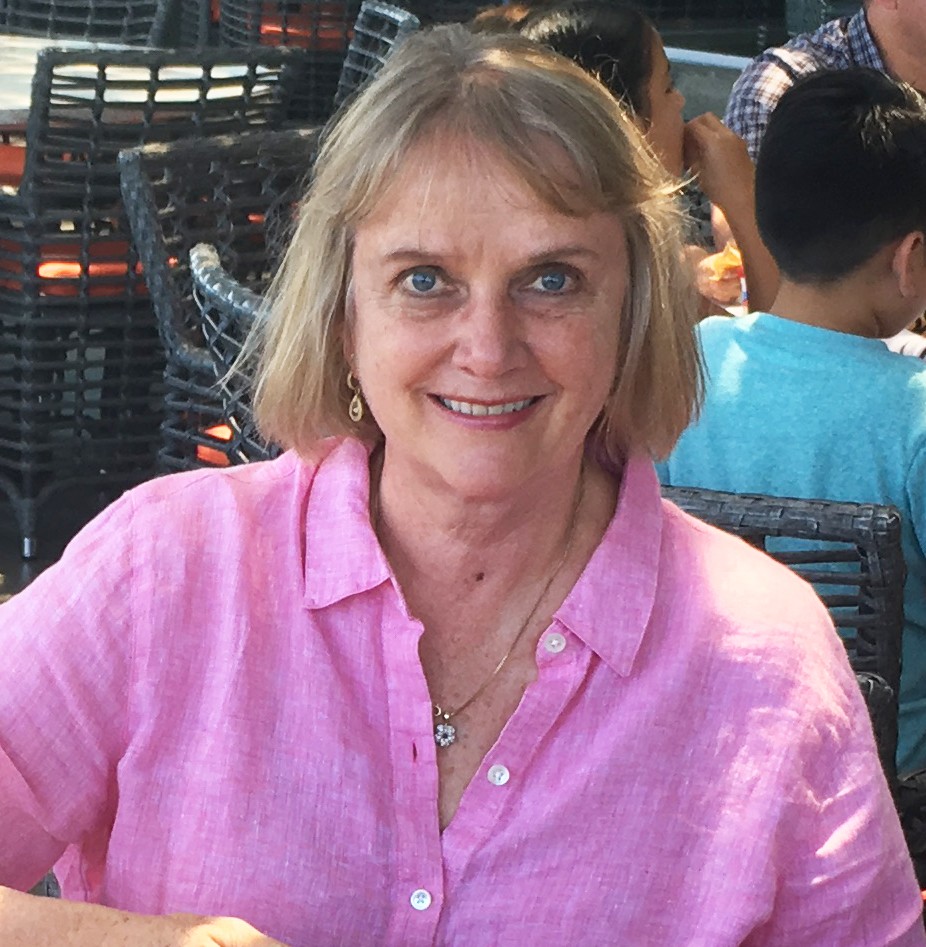
Image courtesy of Tina Yelle.
Tina Yelle
Tina Yelle (1952– ) started out as a painter, earning a BA from Wheaton College (1975) and an MFA from Pratt Institute (1981). In 1985, she became executive director of the New York Experimental Glass Workshop in New York City. Tina Yelle led the workshop for a decade, overseeing the organization’s move from Manhattan to Brooklyn in 1991 and its rebranding as UrbanGlass. Since 1995, Yelle has worked for a software and consulting firm specializing in planned giving.
Works
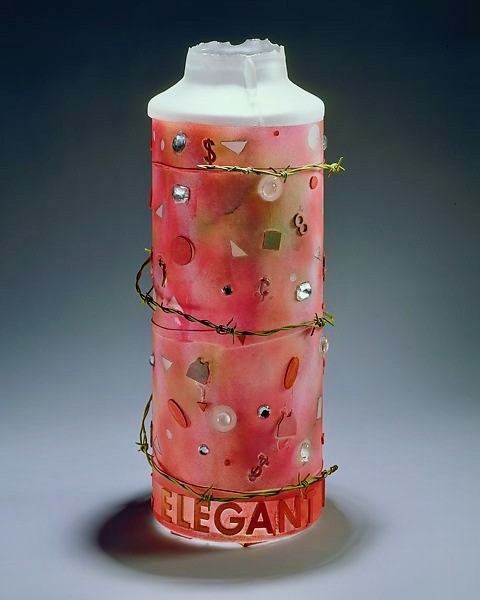
Elegant, 1991. Glass, oil, wax, paint, graphite, and barbed wire. H: 22.75 in, D: 9.75 in. Collection of the Metropolitan Museum of Art, New York. Image courtesy of Richard Yelle. Gift of Mary and Gary Pforzheimer.
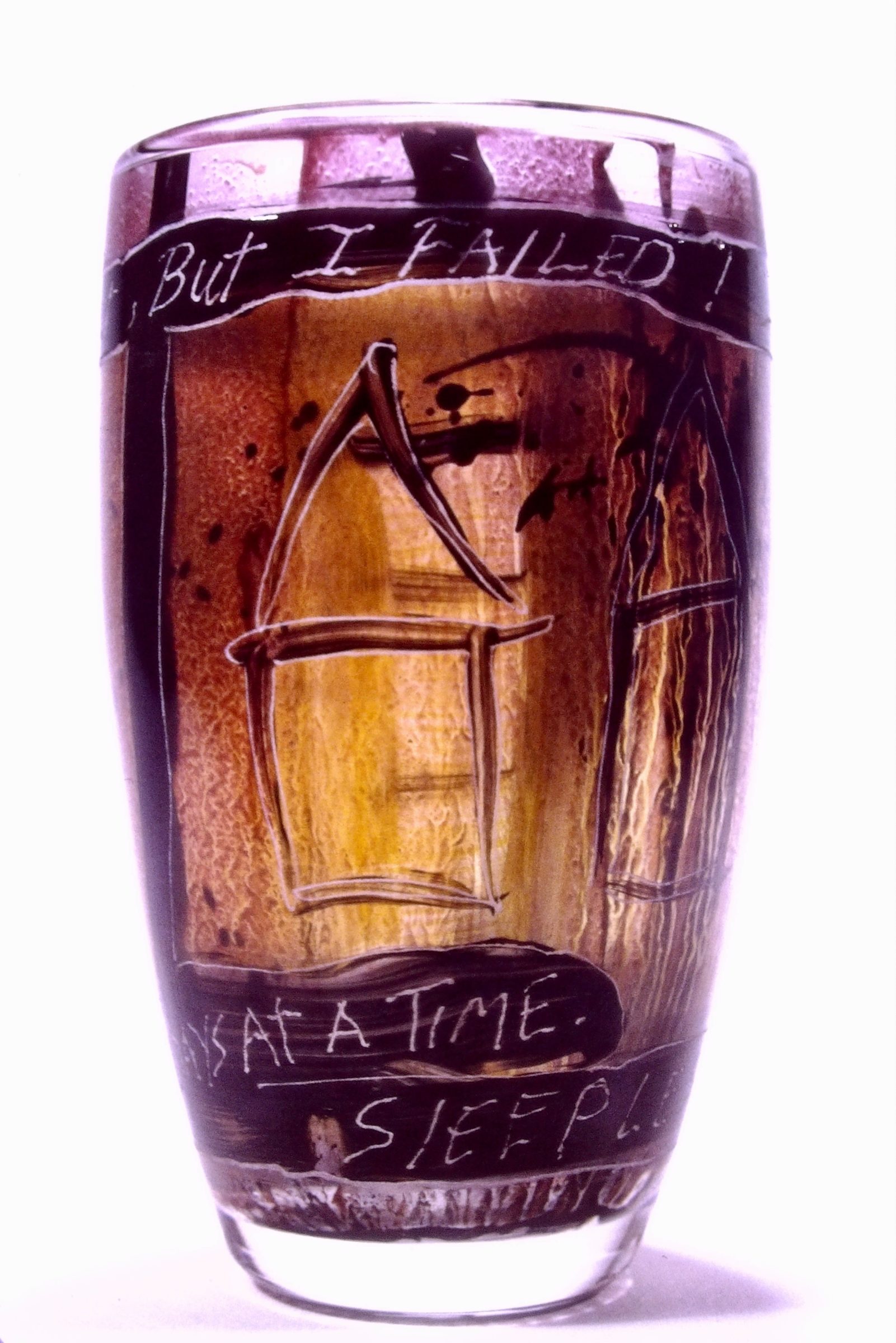
Reason It Out, 1990. Colorless leaded glass, polychrome enamels. H: 19.2 cm, D: 11.6 cm. Collection of The Corning Museum of Glass, Corning, New York. Image courtesy of Richard Yelle.
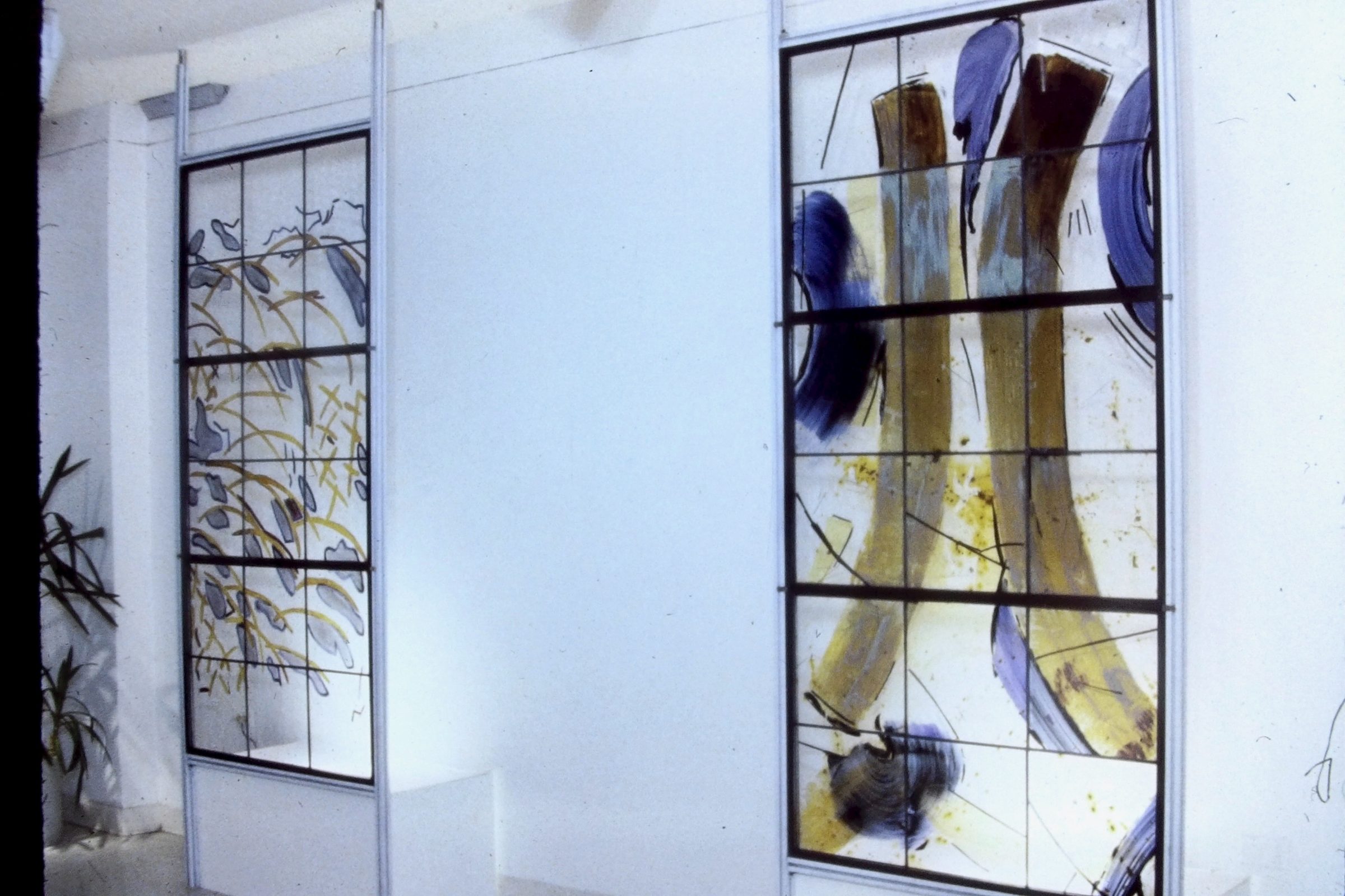
Panel, 1981. Leaded glass, high temp enamel. H: 72 in, W: 36 in. Image courtesy of Richard Yelle.
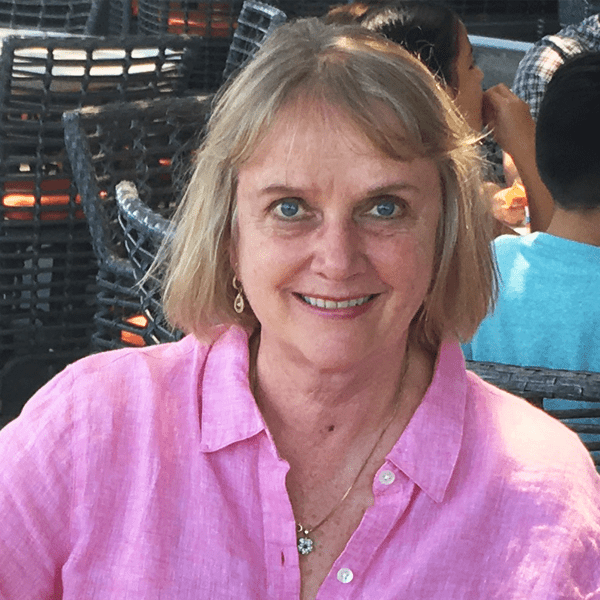
Tina Yelle speaks about experimentation and the culture of New York Experimental Glass Workshop during its tenure on Mulberry Street.
Playing04:16 TranscriptTina Yelle speaks about experimentation and the culture of New York Experimental Glass Workshop during its tenure on Mulberry Street. Oral history interview with Tina Yelle by Catherine Whalen, conducted via telephone, April 30, 2019, Bard Graduate Center. Clip length: 04:16.
Time stamp: 00:00
Clip 1: Tina Yelle talks about NYEGW embracing all types of glassmaking. Clip length: 01:02.
Tina Yelle: If an artist came in and they wanted to do experimental sculpture, that was fine. If they wanted to pursue traditional or paperweights, we didn’t care. It was completely accessible in that sense, intentionally so, and we wanted it to be open to any kind of a thought or approach. Just, ‘Here’s the equipment, pay for an hour or two or three, and do what you want.’ At the same time, from the very beginning, it had curated and competitive programs. So the visiting artist program, the magazine, the gallery, were selective. And so I personally love that happy living together of selective and non-selective. And I also like the fact that we had many forms of glass, not just glassblowing. And so it was a non-judgmental embracing of a medium in a way that people don’t always get to experience once they leave school.
Time stamp: 01:05
Clip 2: Tina Yelle discusses the “mixed media” nature of NYEGW. Clip length: 01:23.
Tina Yelle: A lot of artists worked in a more mixed media way. You know, a little wood, a little paint, a little neon, a little flat glass, you know, assembled together in some way. And Mulberry Street was a couple of blocks from SoHo which was actually an artist area in the eighties. And so, that’s the other thing about the Experimental; because of Richard’s attitude and the attitude of the other people who were there and our location, we definitely embraced the wider art world and we invited people from outside of the so-called ‘glass world,’ and we were not interested in having, you know, strict barriers or definitions, and in our visiting artist program over the years we invited artists who were not known in glass and may have never worked in glass, like Lynda Benglis, I’m sure you were aware of her association with us. And there were others over the years. So again, the thing I liked was that it kind of corresponded with my own attitudes toward art and I’m sure Richard’s, because Richard and Joe Upham, they started the place, and these were the programs that were in place when I took over.
Time stamp: 02:31
Clip 3: Tina Yelle talks about the culture of NYEGW in the 1980s. Clip length: 01:02.
Tina Yelle: It was so much fun in the eighties. SoHo was in New York, this whole community at the Experimental, the attitudes, it was really fun and open, and I guess I’m not self-consciously bound by convention all of the time. ‘Cause I wrote my first fundraising letter [laughs.] I’m laughing to think about it. I don’t even know if I have a copy of it anywhere. The first fundraising letter that wasn’t just a state or national grant application that was going to be sent to our individual supporters, I just made up something, I said ‘Dear Glass Glug.’ It didn’t mean anything [laughs] and this was typed on a typewriter, we didn’t have a computer yet. And it had little hand drawings throughout the letter. And it was—looking back on it, I think it was wildly eccentric. But at the time, I just thought it was—you know, I’ve got to do something, we gotta raise some money. And we got a good response. We got money.
Time stamp: 03:36
Clip 4: Tina Yelle explains that artists weren’t “traditionally glass” at NYEGW. Clip length: 00:40.
Tina Yelle: And the fact that we had a lot going on with artists who weren’t strictly glass or traditionally glass, and the people in our, you know, regular circle were fascinated and interested. So, I really didn’t feel that we had the good ole art versus craft—hierarchy. I think that we had less of that than almost any place.
PermalinkTina Yelle discusses running and maintaining New York Experimental Glass Workshop at Mulberry Street.
Playing09:28 TranscriptTina Yelle discusses running and maintaining New York Experimental Glass Workshop on Mulberry Street. Oral history interview with Tina Yelle by Catherine Whalen, conducted via telephone, April 30, 2019, Bard Graduate Center. Clip length: 09:28.
Time stamp: 00:00
Clip 1: Tina Yelle talks about growth and transition at NYEGW. Clip length: 00:59.
Tina Yelle: Well, when I joined the organization, it was very small and ramshackle, it had a budget of under $200,000 a year. And it wasn’t a very well-funded transition, to say the least. And there was a lot of transition while we were still on Mulberry Street, and then the, you know, the move to Brooklyn it’s kind of like a growing-up process, in a way for the organization, and certainly while I was involved, I always cared about art, you know? So I tried to keep that focus on the organization. Not collecting, not shopping, not anything else, but I really cared about artists and art. And I didn’t care what they did, but that’s what I cared about.
Time stamp: 01:01
Clip 2: Tina Yelle talks about NYEGW artists’ need for better glass and a better furnace. Clip length: 02:46.
Tina Yelle: Let me tell you a brief story about when I first started. Well, so I walk in there and I had absolutely no experience in anything relevant because I had managed—lucky me, I had managed until I was about 30 to flit around and paint and do nothing productive or career-oriented. So, you know, no organizational experience or anything like that. But I walked in there, and almost no staff, mostly a barter system and you’re probably aware that when you have a hot glass operation, you have to feed the monster every night. And then it has to cook, and then you have to get stuff out of the annealers in the morning. So, we had a barter system where people, usually the instructors who would teach at night would charge the furnaces afterwards, and someone else would come in the morning and, you know, empty the annealers and so on. And usually those people were trading for studio time. You know, a large glory hole, hot glass even in those days was twenty or thirty dollars an hour. And in 1985 for a young artist, if you’re serious about blowing and you want to have ten hours of blowing time a week, where’re you going to get that money? Especially if you’re not making something saleable. So there was a barter system. Every single person had a key, and I guess the guy who was my predecessor just didn’t pay much attention. He drew a salary and didn’t do much work, the place was running in the red, and it was pretty ramsack—shackle. So, what I did is I actually talked to the artists, and I said, ‘What do you need? What do you want?’ And the first thing that they said to me was they wanted better quality glass. And so I walk in there, I know zilch, we’re running a deficit, and the first thing that we decide to do is build a new furnace [laughs] Cause, well, the artists wanted better glass. And we had like a tank furnace, which was fine for teaching classes and so on—that’s another thing we did—had been doing all along is classes. And we built another furnace that had a pot furnace and it had better quality glass which was more for the professional artist and at the end of about my first year, whatever the timing was, we had a guy come in, Stanley Balsky, who did our audit for years. And I think that I hadn’t opened any bank statements or done any kind of accounting. And Stanley’s rolling his eyes and he thinks this is going to be a disaster, and then he did the work in our office over several days and kept scratching his head very perplexed. And so I had wiped out the deficit and shown a profit for the first time, and it made sense, because our product was glass, and if we had good glass, reliable service, stuff ready on time, and focused on the essentials, artists came.
Time stamp: 03:50
Clip 3: Tina Yelle talks about managing to keep NYEGW safe and in order. Clip length: 01:37.
Tina Yelle: Essentially, no one was minding the shop before, and I came in and I just—I loved it. I loved the people. I loved the attitude, and it’s more or less that somebody was there minding the store, making sure that people did actually pay for things. You know, if you have classes, advertise them a bit so people come. And people—artists would be very discouraged if they came in and the glass was bad. You know, if you’re paying $60 for a couple of hours of hot time and then you take your stuff out of the annealer the next day and it explodes because the glass is bad quality or the annealer temperature was wrong or something, you’re not happy. So, anyway, that was really fun. I really enjoyed that. And I am still amazed and grateful that we never blew up anything. Here we have—we didn’t have a licensed plumber in sight, right? And, you know, plumbing is how you move gas around. So we had this place crawling with, you know, furnaces, gas, all of this stuff, electricity, water everywhere, this bombarder, all built by artists with no electrical or plumbing license. And we never blew up [laughs] which was really, really good.
Time stamp: 05:29
Clip 4: Tina Yelle discusses NYEGW’s introduction to Carl Pfozheimer. Clip length: 02:20.
Tina Yelle: You’ve probably come across Carl Pforzheimer who’s been on the board for many many years. Well, here’s one of those ‘it’s a small world’ things. Richard and I were down there in New York, and so on. Meanwhile, my youngest sister Mary who’s nine years younger was living up here in Cambridge and—at her first job out of Bryn Mawr [Bryn Mawr College, Bryn Mawr, Pennsylvania]. She was working at a Harvard [Harvard University, Cambridge, Massachusetts] office and met an undergraduate there named Gary Pforzheimer and they married, had three kids, and lived happily ever after. So just like any young couple who fall in love and talk, they tell each other about their family, and Mary says, ‘Oh, by the way, my brother Richard started a glass organization in New York,’ and Gary says, ‘Really? My parents collect glass.’ And that was just totally random. So of course we hear about it. Carl comes down to Mulberry Street for a tour, and I meet him there, and he loves glass, and we set him up taking glassblowing lessons every Saturday with Bill Gudenrath. And talk about, you know, a match made in heaven. They had so much in common: music, glass. They just liked each other; food, you name it. And so Carl was really wonderful. Naturally, I got the hang right away of inviting people to be board members based on their ability to help. And he had all the experience in the world on organizational development, how to run a board, how to do everything that I didn’t have, and so he agreed to join the board. He told us that he’d be the treasurer, thank you very much. And he was just instrumental. He recruited people to help me. For instance, he recruits some twenty-something Wall Street banker to come up and teach me Excel, and then he recruits somebody else from GE [General Electric Company, New York, New York] to talk about more general business things and then he recruits other people. He was just somebody who quietly, with no fanfare, just was helpful. And, you know, he was one of many influences that help the organization kind of grow from where it was in 1985 to an organization that was—you know, we had a couple million dollar capital campaign; doesn’t sound like much today, but it was a lot for this organization with a budget of $150,000 a year, the first year, in order to move to Brooklyn.
Time stamp: 07:52
Clip 5: Tina Yelle describes her love of the people, culture, and rawness of NYEGW’s Mulberry Street space. Clip length: 01:35.
Tina Yelle: I didn’t really think of it as collaboration, though I think that that probably is a pretty accurate term for what it was. It comes from liking something. I liked everything about the concept. You know, so philosophically I was very in-tune with things I cared about. I liked the people. I liked the mess. I mean, you’ve seen photos of Mulberry Street. It was pretty rustic, and glass is a messy business. You’re hot, you’re sweaty, you’re messy, you’re splashing water on the floor. Your—you know, your clothes get dirty. It’s—you know, I like mess—and I just like people. And I don’t generally like people, I wouldn’t say that I’m somebody who just likes everybody, cause I don’t, but I think that what you’re seeing as collaboration came from that. I liked what was going on and I like the people involved and it was natural to just work hard, and there was a lot of trust because as I say, everybody had a key. You know, there were people in and out of there night and day, and there’s a lot of responsibility. And we had, I’d say, in the ten plus years that I was involved, there might have been one or two incidences when there was any hint that somebody might have stolen something. So that was in Brooklyn when we were much bigger and had a much larger group of people coming in and out. But, generally there was a lot of trust and respect, and it was very collaborative among the artists because they—with hot glass in particular, you can’t do it alone.
PermalinkFormer NYEGW Director Tina Yelle talks about why her brother, Richard Yelle, wanted to start a glass facility in New York.
Playing01:05 TranscriptTina Yelle talks about why her brother, Richard Yelle, wanted to start a glass facility in New York. Oral history interview with Tina Yelle by Catherine Whalen, conducted via telephone, April 30, 2019, Bard Graduate Center. Clip length: 01:05.
Tina Yelle: But he was an artist, he wanted to move to New York, and I think the key thing that Richard was aware of and that was very central to my thinking, is that glass is not a, a medium that allows an artist—a young artist—to pursue it in and experiment once they’re out of school because it’s too expensive. You get into the goblet trap. For hot glass in particular, but also cold glass, neon, casting, all sorts of glass media, it’s very expensive to rent a studio space; the utilities, the materials, the upkeep are extremely expensive, and so an artist who tries to pursue their own work on their own gets faced with the economics of needing to make saleable items to keep the furnace lit. And so the Experimental was, philosophically—I think it just had the right attitude at the right time.
PermalinkTina Yelle describes raising money for NYEGW. Oral history interview with Tina Yelle by Catherine Whalen, conducted via telephone, April 30, 2019, Bard Graduate Center. Clip length: 00:55.
Tina Yelle: And the other thing is, that looking at some of those workshop photos and so on, I don’t think I can take credit for inviting all of these really great, interesting people to the workshop. [clears throat] I was the mechanics person in the background, raising the money making things happen in that way, but I didn’t say, ‘Oh, we should have Gianni Toso come.’ It was the people who had a deep connection in history with glass that wanted Gianni Toso or whomever to come, and made that kind of thing happen. But I think that people who came like that enjoyed the vibe of New York and the art world in the eighties and in the nineties.
PermalinkTina Yelle talks about Lino Tagliapietra being “the star” of Chihuly’s 1992 Venetian workshop at NYEGW.
Playing00:58 TranscriptTina Yelle talks about Lino Tagliapietra being “the star” of Chihuly’s 1992 Venetian workshop at NYEGW. Oral history interview with Tina Yelle by Catherine Whalen, conducted via telephone, April 30, 2019, Bard Graduate Center. Clip length: 00:59.
Tina Yelle: The thing that struck me in seeing the photos was having Dale [Chihuly] there not being the star, cause it was a Lino [Tagliapietra] workshop really. And that just reminded me of how artists really were supportive of each other and interested in what each other could do. Everyone I knew absolutely adored Lino. They thought learning how he did things, learning from him was extraordinary, and of course, he was such a terrific guy—very easy to be around. So yeah, I think that that cross-fertilization of different traditions was exciting on both sides—one that both Lino and Dale were getting something out of it.
PermalinkTina Yelle talks about the transition from New Work magazine to Glass Quarterly.
Playing01:11 TranscriptTina Yelle talks about the transition from New Work magazine to Glass Quarterly. Oral history interview with Tina Yelle by Catherine Whalen, conducted via telephone, April 30, 2019, Bard Graduate Center. Clip length: 01:11.
Tina Yelle: I think that the glass community was ready for a magazine like Glass when it came out, and it was full of advertising and so much more color glossy than New Work had been. And I think it was gorgeously designed. Richard brought in talent and we got so much volunteer—you know, great New York artists to come in and design that for us. And I don’t know that we paid anything for that design. And I think that the first issue of Glass in particular is just one of the best examples of graphic design and typography and photography; you know, it’s just outstanding. So I think that revealed the—the desire of collectors to have something to read and look at that was really focused on glass. The reception to the magazine was, I think, very good, and so I think that the collectors kind of elevated—the magazine elevated their place in things, cause they were clearly an audience for it. Whereas New Work was really more directed to artists, maybe.
PermalinkTina Yelle describes raising money for NYEGW. Oral history interview with Tina Yelle by Catherine Whalen, conducted via telephone, April 30, 2019, Bard Graduate Center. Clip length: 01:00.
Tina Yelle: Let me tell you how I got involved. I’m a painter—I was trying to be a painter, not a glass artist, and I had been living in Europe, and I was one of those people that didn’t really have a career path, per se. I wanted to paint. I came back from Europe to New York, and I was working a dead-end temp job. And Richard—of course he knew that, we were very close. He went down to the Workshop one day and found the place in disarray, I guess; you can get his version. He fired the director on the spot, and then in his typical bossy brotherly way, he phoned me up and told me to get down there the next day because I was just working a stupid temp job, and he just needed a warm body in there. So I thought that was fantastic. Of course, I’m young, open-minded, didn’t care, walked down there and it’s kind of like love at first sight. Not so much the glass itself, but the artist attitude.
Permalink